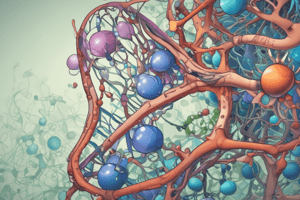Podcast
Questions and Answers
The tertiary structure of DNA refers to its nucleotide sequence.
The tertiary structure of DNA refers to its nucleotide sequence.
False (B)
DNA is a complex molecule that holds all information necessary for building and maintaining an organism.
DNA is a complex molecule that holds all information necessary for building and maintaining an organism.
True (A)
The secondary structure of DNA is primarily a single-stranded helix.
The secondary structure of DNA is primarily a single-stranded helix.
False (B)
Nucleotides in RNA contain the nitrogenous bases adenine, guanine, cytosine, and thymine.
Nucleotides in RNA contain the nitrogenous bases adenine, guanine, cytosine, and thymine.
In nucleic acids, phosphate groups are bound to the 5' carbon of the sugar.
In nucleic acids, phosphate groups are bound to the 5' carbon of the sugar.
Uracil is a pyrimidine base found in DNA.
Uracil is a pyrimidine base found in DNA.
The strands of DNA are oriented in a parallel fashion.
The strands of DNA are oriented in a parallel fashion.
Watson and Crick's model of DNA structure primarily highlighted the role of phosphodiester bonds.
Watson and Crick's model of DNA structure primarily highlighted the role of phosphodiester bonds.
Cytosine always pairs with Thymine in DNA.
Cytosine always pairs with Thymine in DNA.
The backbone of a DNA molecule consists of ribose sugar and phosphate groups.
The backbone of a DNA molecule consists of ribose sugar and phosphate groups.
Phosphodiester linkages in nucleic acids are formed between the 3-hydroxyl group of one sugar and the 5-phosphate group of another sugar.
Phosphodiester linkages in nucleic acids are formed between the 3-hydroxyl group of one sugar and the 5-phosphate group of another sugar.
Hydrophobic interactions contribute to the stability of the DNA double helix.
Hydrophobic interactions contribute to the stability of the DNA double helix.
DNA contains both purine and pyrimidine bases.
DNA contains both purine and pyrimidine bases.
Study Notes
Central Dogma of Molecular Biology
- Central dogma: DNA transcribes to RNA, which translates to protein.
- Fundamental principles of molecular biology explaining gene expression.
What is DNA?
- Deoxyribonucleic acid (DNA) is crucial for organism development and function.
- Acts as the primary unit of heredity across all organisms.
Structure of DNA
- Three hierarchical levels of structure:
- Primary: nucleotide sequence.
- Secondary: double-stranded helical structure.
- Tertiary: higher-order folding for DNA packaging.
Nucleotides
- Common structure: composed of sugar (deoxyribose), phosphate group, and nitrogenous base.
- Carbons in sugar are numbered, crucial for understanding nucleotide connectivity.
Nitrogenous Bases
- Two types of bases:
- Purines: Adenine (A) and Guanine (G).
- Pyrimidines: Cytosine (C), Thymine (T) in DNA, and Uracil (U) in RNA.
DNA Helix Structure
- Composed of two coiled strands forming a double helix.
- Sides are made of deoxyribose sugar linked to phosphate groups via phosphodiester bonds.
- Center consists of nitrogen bases joined by weak hydrogen bonds.
Nucleotide Chain Directionality
- Nucleotide sequences are represented from 5’ to 3’ direction.
- Phosphodiester bonds link the 5’ phosphate of one nucleotide to the 3’ hydroxyl of another.
Watson and Crick Model
- Watson and Crick developed the three-dimensional model of DNA structure.
- Native DNA formed by complementary antiparallel chains.
Stability of DNA Double Helix
- Stability achieved through:
- Hydrogen bonding between complementary base pairs (A-T and G-C).
- Hydrophobic interactions between stacked planar bases.
Visual Representation of DNA
- Rungs of the ladder represent nitrogenous bases.
- Legs of the ladder are formed from the sugar-phosphate backbone.
Studying That Suits You
Use AI to generate personalized quizzes and flashcards to suit your learning preferences.
Description
Test your knowledge on the core concepts of genetics and molecular biology, focusing on the central dogma of molecular biology, which encompasses DNA, RNA, and protein synthesis. This quiz is based on the 'Lehninger Principles of Biochemistry' and will challenge your understanding of these fundamental biological concepts.




